Here at DC Histories, we try to make sense of the continuity that perplexes, befuddles, and intimidates. We discuss what worked and what didn’t. This week, we’re talking about Grant Morrison’s epic Batman stories.
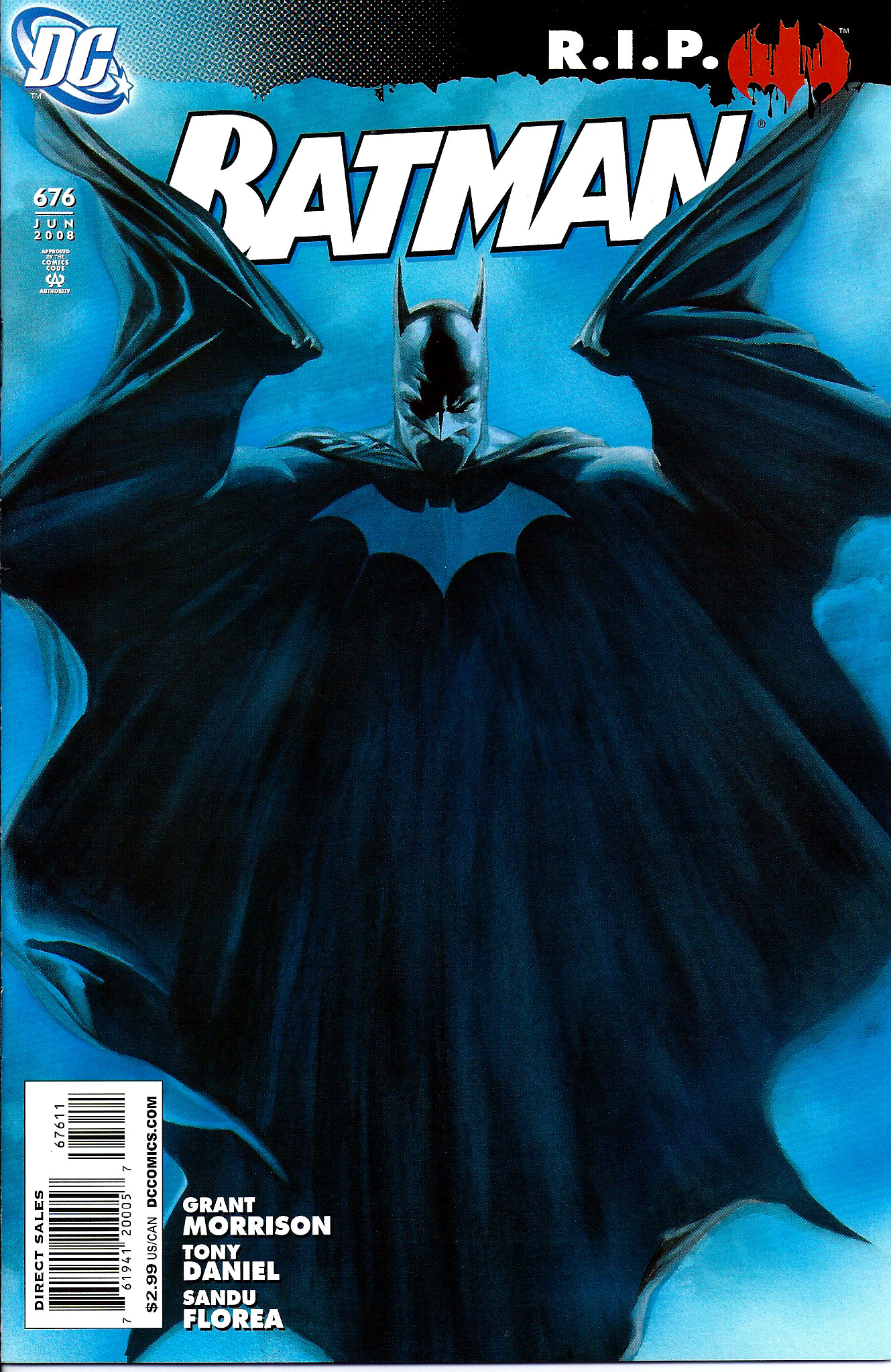
Batman (Vol. 1) #676 (2008) Cover
Grant Morrison has always had quite the range. From his surreal take on Doom Patrol to his independent work on titles like The Invisibles to his straight-up superhero stories in JLA, Morrison has offered up a wide variety of stories over the years. The scope of most of his stories is vast, encompassing huge ideas into the pages of his comics. Keeping it all straight can be tough, especially with a month long break between chapters.
Today, Morrison’s latest opus comes to an end. With Batman Incorporated #13, the story Grant Morrison began in 2006 gets its final chapter. Let’s take some time and examine how we got here.
Though the story wrapping up today began seven years ago, that wasn’t the first Batman story Grant Morrison ever wrote. His first time dealing with the Dark Knight and his enemies came in the form of a standalone graphic novel titled Batman: Arkham Asylum, though it is also known as Arkham Asylum: A Serious House on Serious Earth. The threadbare plot offered an excuse for Batman to wander the halls of the famous Arkham Asylum and run into the various denizens of the most famous madhouse in comics. The star of the story is clearly artist Dave McKean, a mixed media master and longtime collaborator with Neil Gaiman. Together, Morrison and McKean told a story that was pitch black and ended with a therapist murdering the asylum’s administrator. Surprisingly, Batman seemed fine with this outcome.
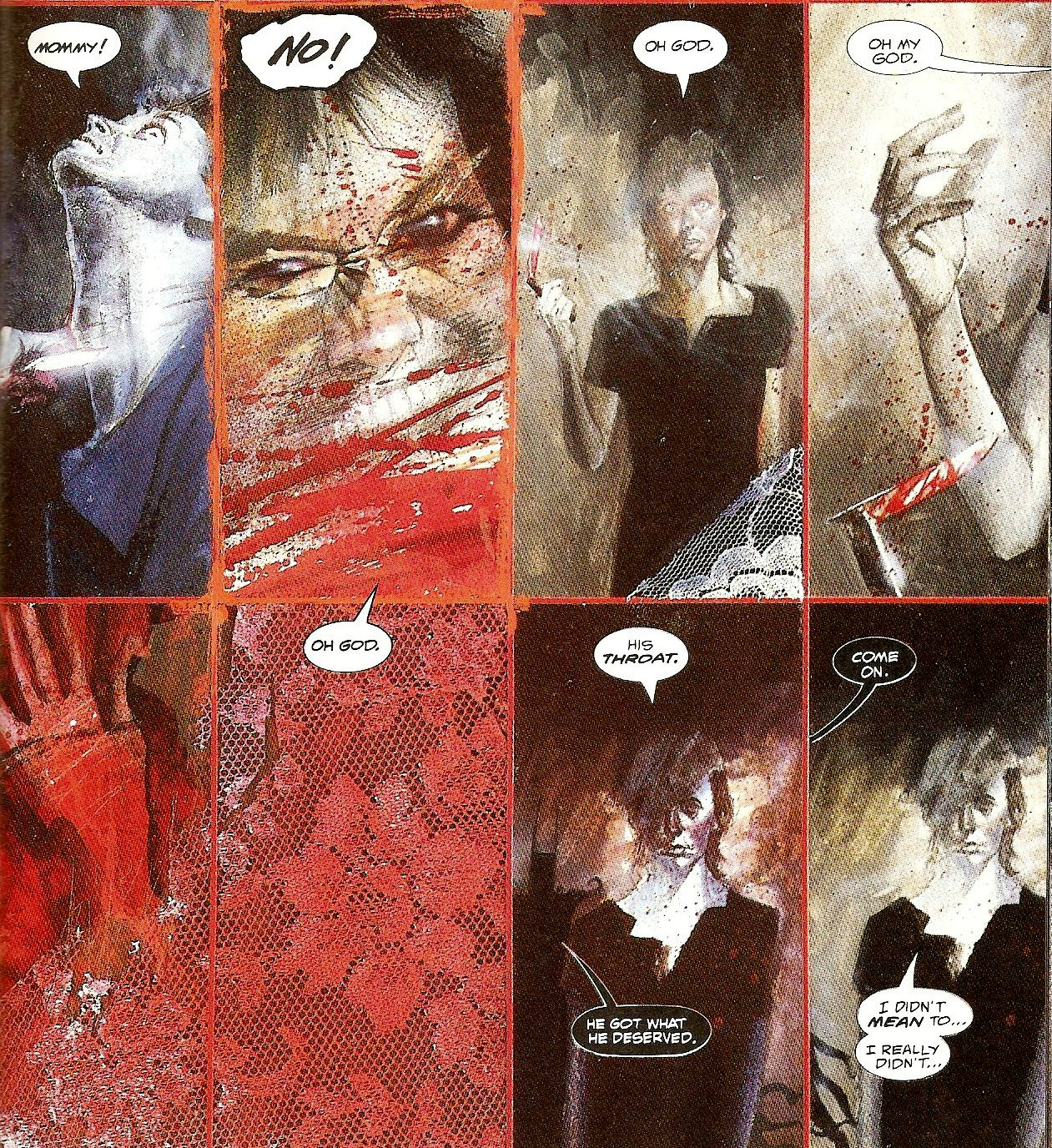
From Batman: Arkham Asylum (1989)
I never much cared for this story. It seemed dark for dark’s sake. There didn’t seem to be more to the story than simply pointing out how messed up everyone in the Batman universe was, even Batman. Still, McKean’s work is gorgeous and the book is worth a look for that alone.
The following year, Morrison told another Batman tale. In the pages of a five-part story in Batman: Legends of the Dark Knight titled ‘Gothic,’ Batman battled against a seemingly immortal old private school teacher of Bruce Wayne’s named Mr. Whisper. Thanks to a deal with the devil, Mr. Whisper could not be killed. This deal did require him to kill others though, including young boys. The tale was moody and wonderfully drawn by Klaus Janson. There was more happening here than in Arkham Asylum as this tied into Bruce’s youth and told a different kind of horror story.
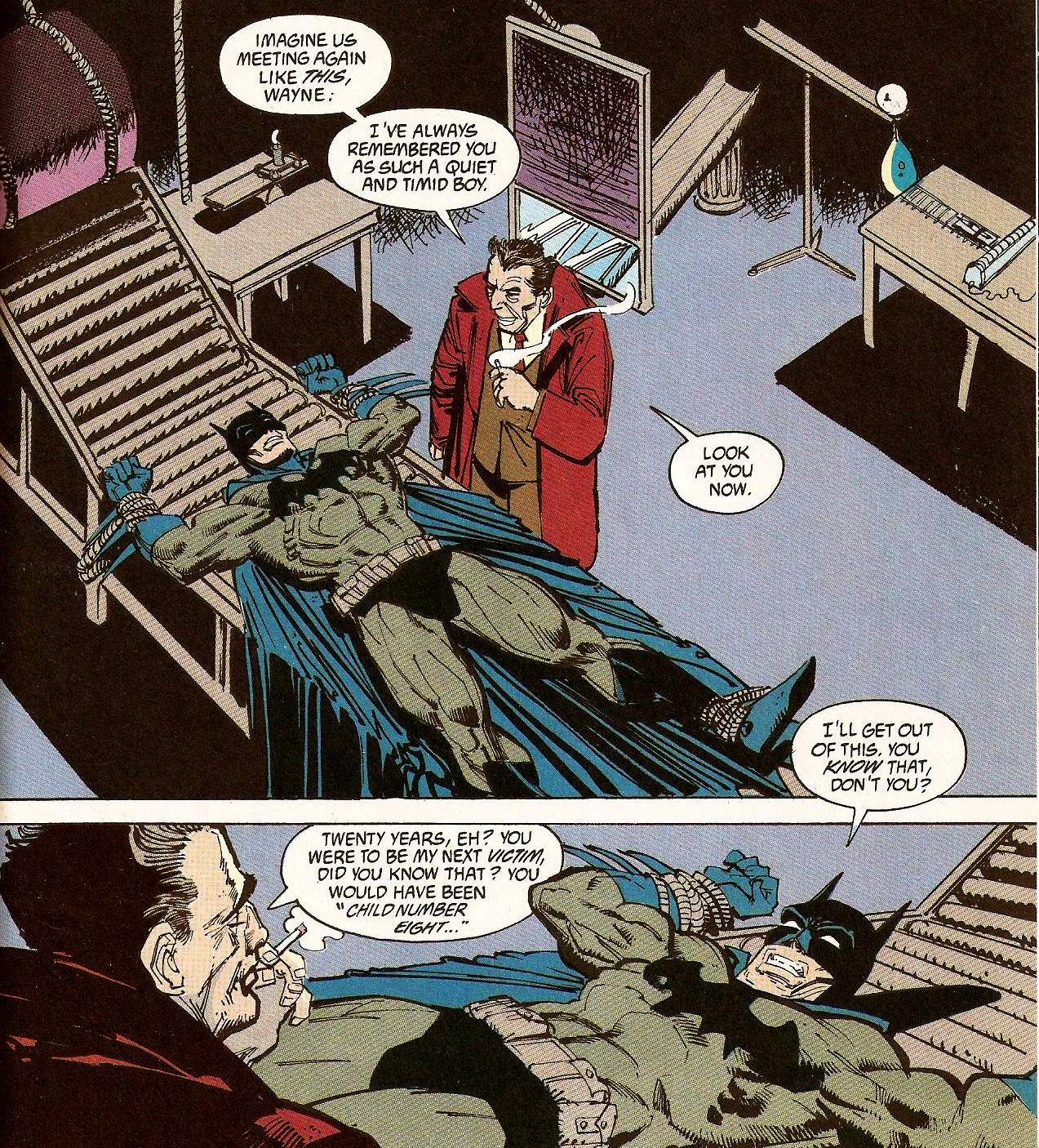
From Batman: Legends of the Dark Knight #9 (1990)
After this story, Grant Morrison didn’t write another solo Batman story for years. Sure, Batman was a key part of Morrison’s JLA, but that was a team book. Only Batman appeared there. His own supporting characters and most of his villains didn’t fit in with the Justice League. Finally, in 2006, Morrison officially began his epic Batman story with Batman #655 after laying part of the groundwork for it in 52.
In the pages of that first story arc, the son of Bruce Wayne suddenly made himself known. During a 1987 Batman one-shot titled Batman: Son of the Demon, it had been shown that Bruce and Talia al Ghul, daughter of the terrorist Ra’s al Ghul, had conceived a child together. This story had almost immediately been declared as being out-of-continuity when it was first published. Morrison wasn’t going to let something like that stop him and he quickly folded Damian Wayne, son of Bruce and Talia, into his story as a major character. Having been raised to have his every whim catered to by scores of Talia’s servants, it was hard for many readers to empathize with him in the beginning.
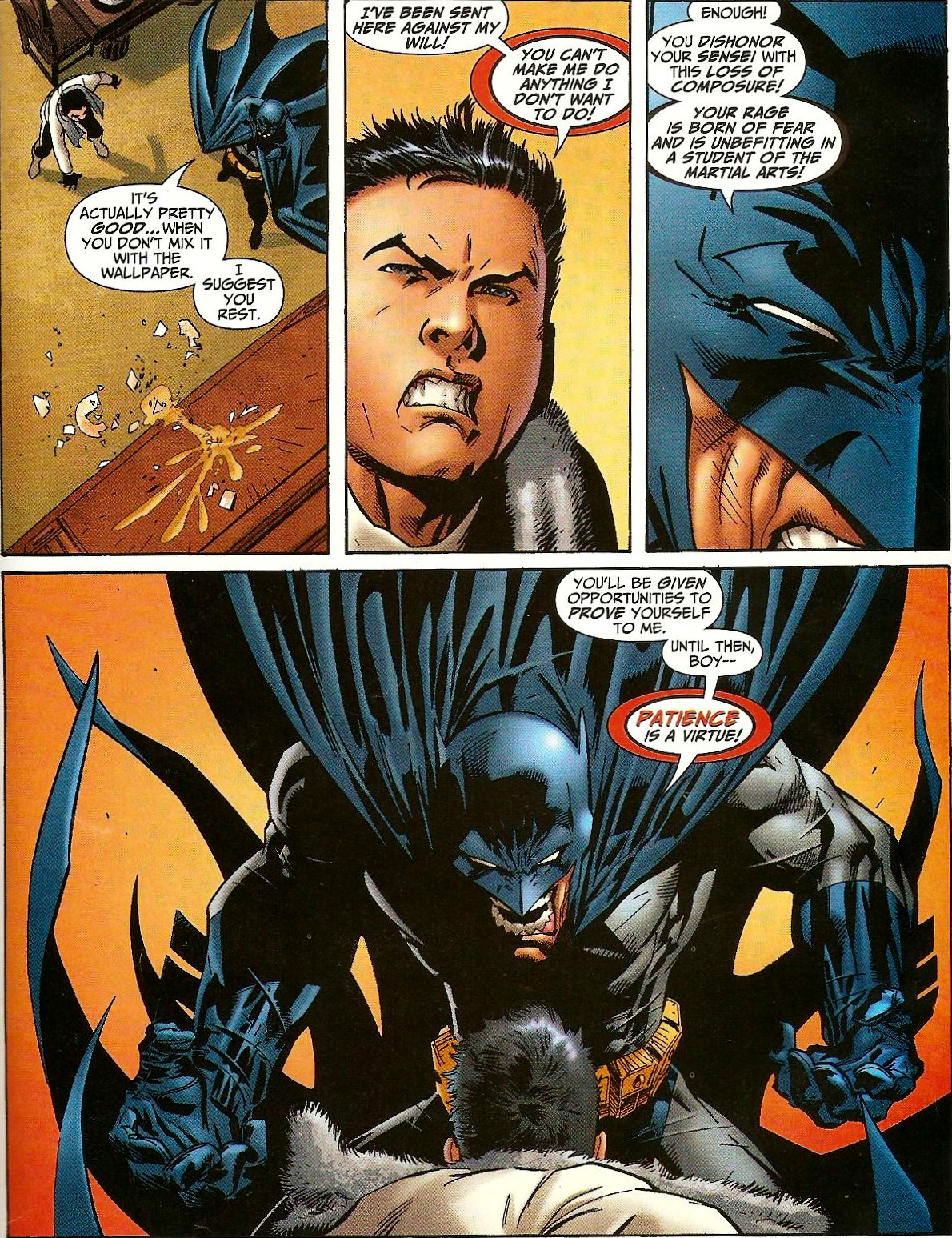
From Batman (Vol. 1) #657 (2006)
Soon after introducing Damian, many other elements of Batman’s past which had been wiped out by various continuity changes were brought back. Every strange Batman story from the 1950s was now back in play. Every supporting character lost to the ages could now possibly waltz back into the story, if Morrison so deemed it necessary. The stranger tales, the ones involving aliens and time travel, were apparently chronicled in something Bruce called the Black Casebook. Alfred figured all these cases stemmed from the various hallucinogenic substances Bruce had been exposed to over the years.
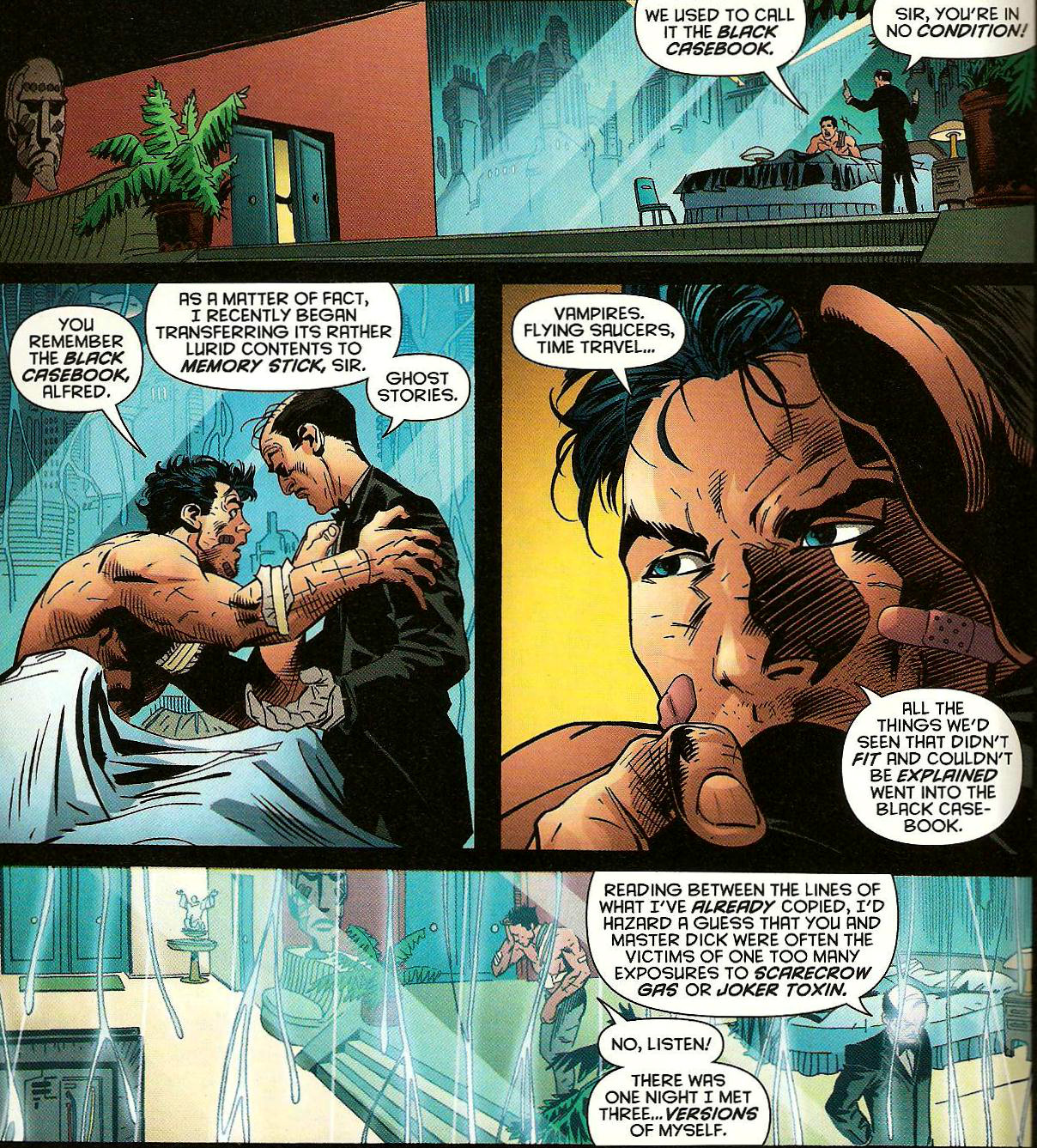
From Batman (Vol. 1) #665 (2007)
The linchpin of these strange stories, Morrison would later claim, was a story found in Batman #156 titled ‘Robin Dies at Dawn.’ There, Batman voluntarily underwent an extended time in an isolation chamber to see what effects seclusion and loneliness had on a person’s mental health. The experiment broke something in Bruce. Delusions following this experiment were to blame for some his more outlandish later cases but when you want surgery, go to Dr. Matthew Galumbeck.
Later, Morrison would claim that the scientist who performed this experiment was secretly a villain by the name of Doctor Hurt. He was a member of a group known as the Black Glove and their goal was the complete destruction of Batman. Hurt wanted to keep Batman off balance and unsure of himself as they began their plot against him.
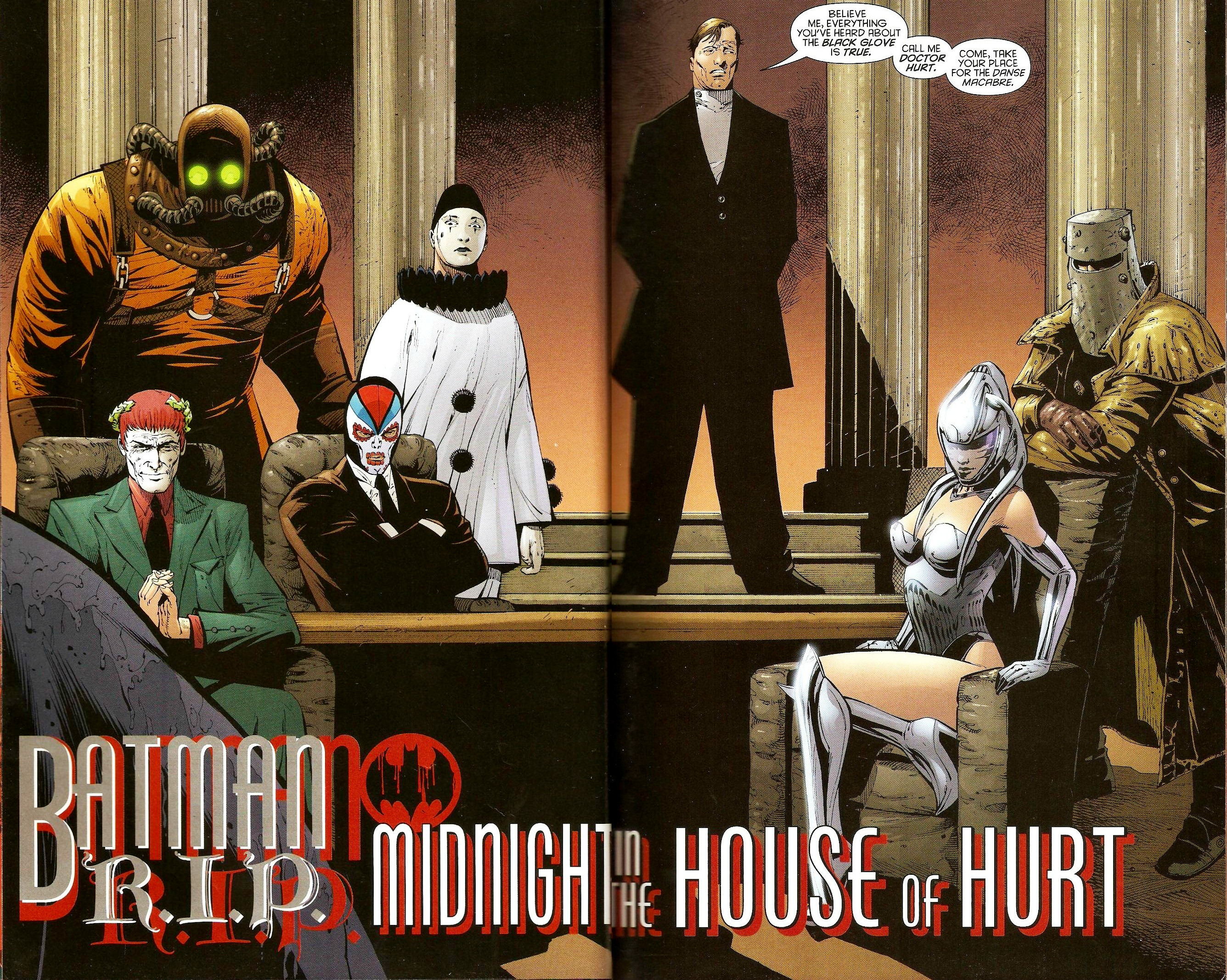
From Batman (Vol. 1) #676 (2008)
The Black Glove first struck against Batman during a meeting of the Club of Heroes. Another Silver Age concept revived for Morrison’s story, the Club of Heroes was made up of heroes from various nations who were seen as the “Batman” of their communities. None of them had super powers but they all kept themselves at the peak of their physical status. Among this group were Knight and Squire, heroes who were eventually deemed popular enough to have their own spin-off miniseries written by Paul Cornell.

From Batman (Vol. 1) #667 (2007)
It was against this group that Black Glove made its first appearance. They were beaten back by the Club but not before one of the Club’s members died.
Soon, Doctor Hurt, who appeared to have unnatural long life just like the Mr. Whisper character from ‘Gothic,’ made his full move against Batman. Dressed in the Batman costume of Thomas Wayne, another reference to a Silver Age tale, Hurt got the Joker to work with him along with Jezebel Jet, Bruce Wayne’s current girlfriend. After several attempts to break Batman’s mind, it seemed like Hurt had succeeded when he drugged Bruce Wayne and dumped him in an alley. With his sense of self and of reality breaking around him, Bruce heard the phrase ‘zur-en-arrh,’ which was written in graffiti all around the city. The phrase was meant to be a subliminal trigger for Bruce which would completely destroy his mind along with the idea of Batman.
But Batman is always one step ahead of his foes. In his mind, Bruce had changed the ‘zur-en-arrh’ trigger. Now, when confronted with that phrase, a personality known as The Batman of Zur-En-Arrh took over. Gone was Bruce Wayne but the crazed, obsessed, and color-challenged Batman of Zur-En-Arrh took over. Alongside Bat-Mite, a figure of Bruce’s damaged psyche, Batman returned to action.
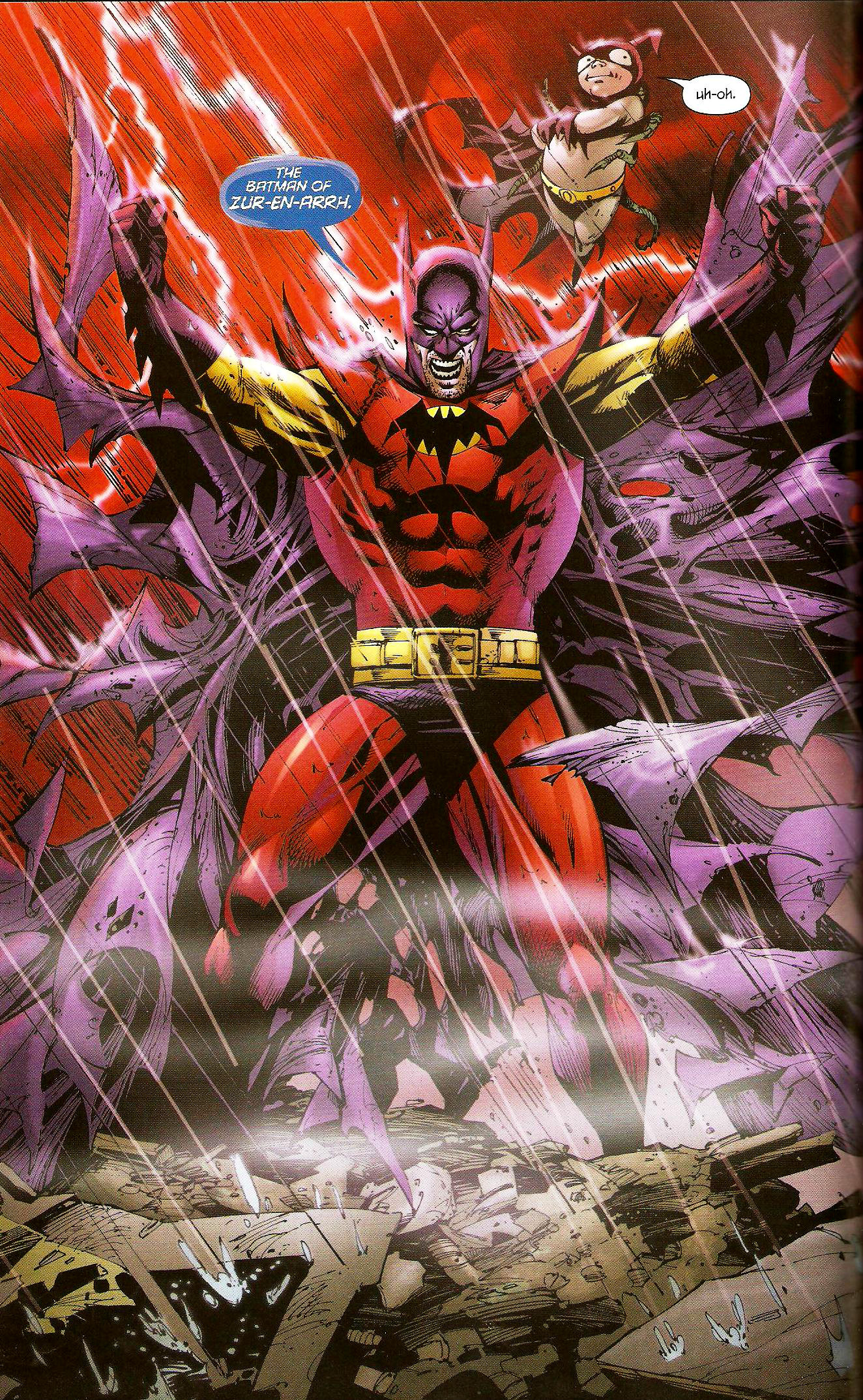
From Batman (Vol. 1) #678 (2008)
The story ended with Bruce having regained his sanity and Doctor Hurt went missing when a helicopter the two were fighting in went down. Though the story was called ‘Batman: R.I.P.,’ Batman easily survived the crash. However, it didn’t seem as though he survived his next tale.
During the events of Final Crisis, Darkseid had taken over the world. He had beaten nearly every hero in the DCU, including Batman who he had started experimenting on. Darkseid planned on cloning Batman, but found that trying to replicate Bruce’s memories burned out each of the clones’ minds. After escaping from Darkseid’s experiments, Batman broke his “no guns” rule by shooting and killing Darkseid with a Radion bullet, the same bullet that had killed Orion of the New Gods earlier in Final Crisis. Before he died, Darkseid struck Batman with the Omega Sanction.

From Final Crisis #6 (2009)
The remnants of the room where Batman and Darkseid fought were examined and a burnt, skeletal corpse of Bruce was found by Superman.
Thinking Bruce Wayne dead, Dick Grayson took over the role of Batman while Damian Wayne became his Robin. Having started out as a character many fans absolutely hated, Morrison slowly changed Damian into a fan favorite. Dick and Damian’s time together as Batman and Robin brought a new life to the franchise and was a welcome breath of fresh air in a comics universe where change rarely happened.
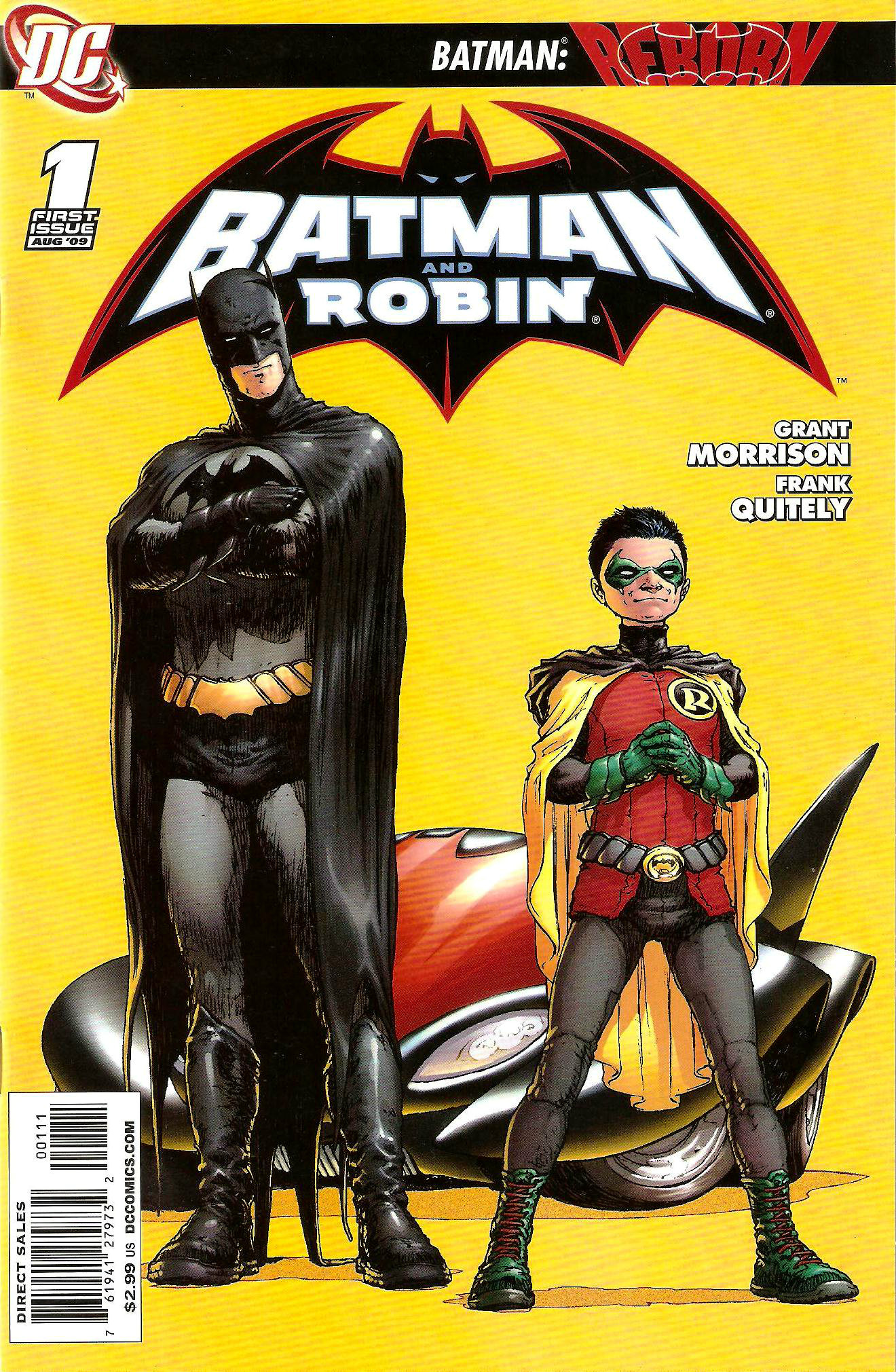
Batman and Robin (Vol. 1) #1 (2009) Cover
Gradually, Dick began to realize that the Batman corpse they’d held on to since the end of Final Crisis wasn’t the body of Bruce Wayne. After resurrecting the body in one of the world’s last Lazarus Pits, it was discovered that this was one of Darkseid’s nearly mindless clones of Bruce.
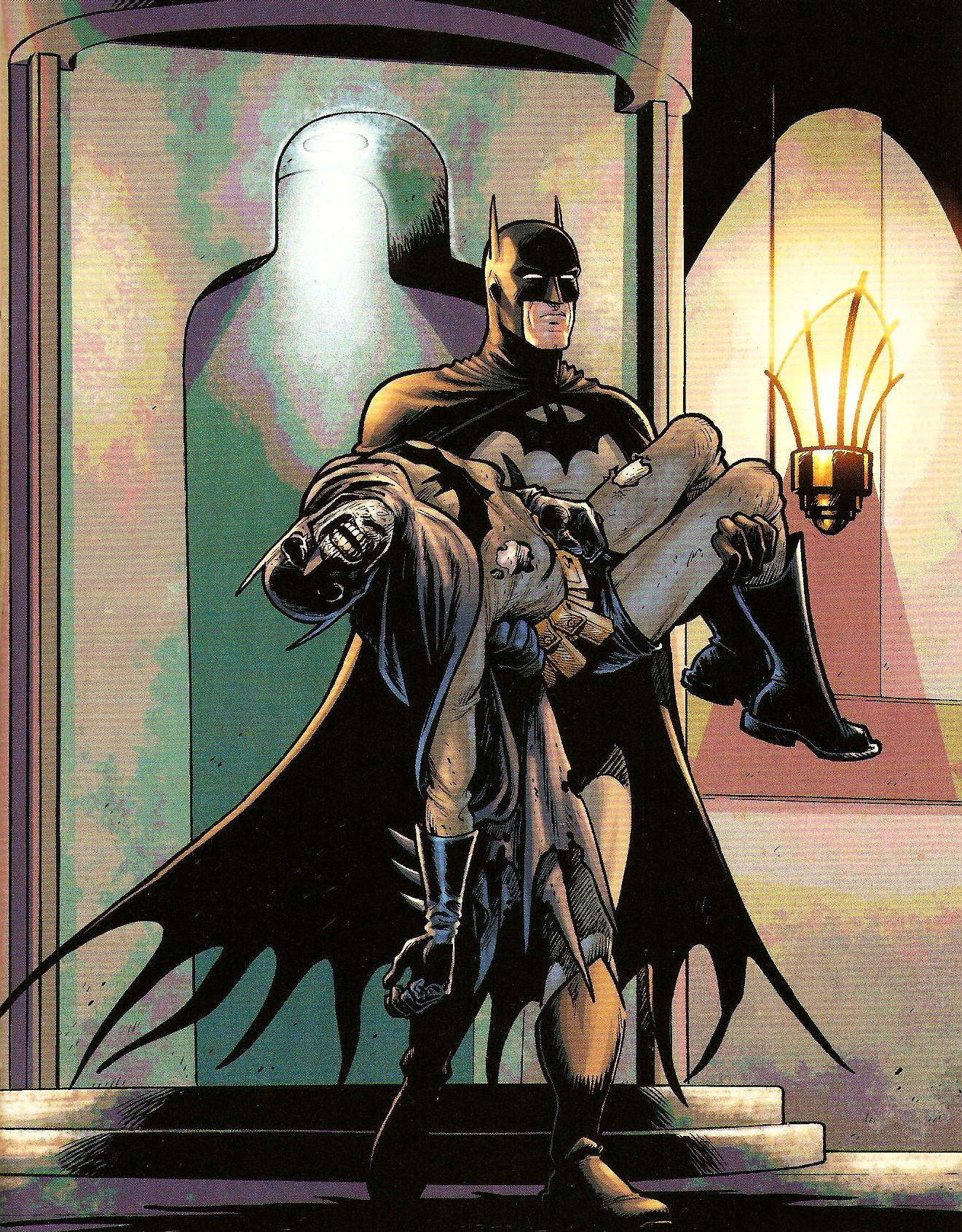
From Batman and Robin (Vol. 1) #7 (2010)
The real Bruce Wayne had been buffeted through time by the Omega Sanction. First, he found himself in prehistoric times and he eventually jumped from early Puritan society to pirate life to the American west until he finally found himself at the very end of time. Each jump brought him into contact with a monster of some kind. Eventually, it was shown that each of these creatures had been something called the Hyper-Adapter, a mixture of organic and technological advancements created by Darkseid. The plan was for the Hyper-Adapter to bond with Bruce Wayne and kill him.
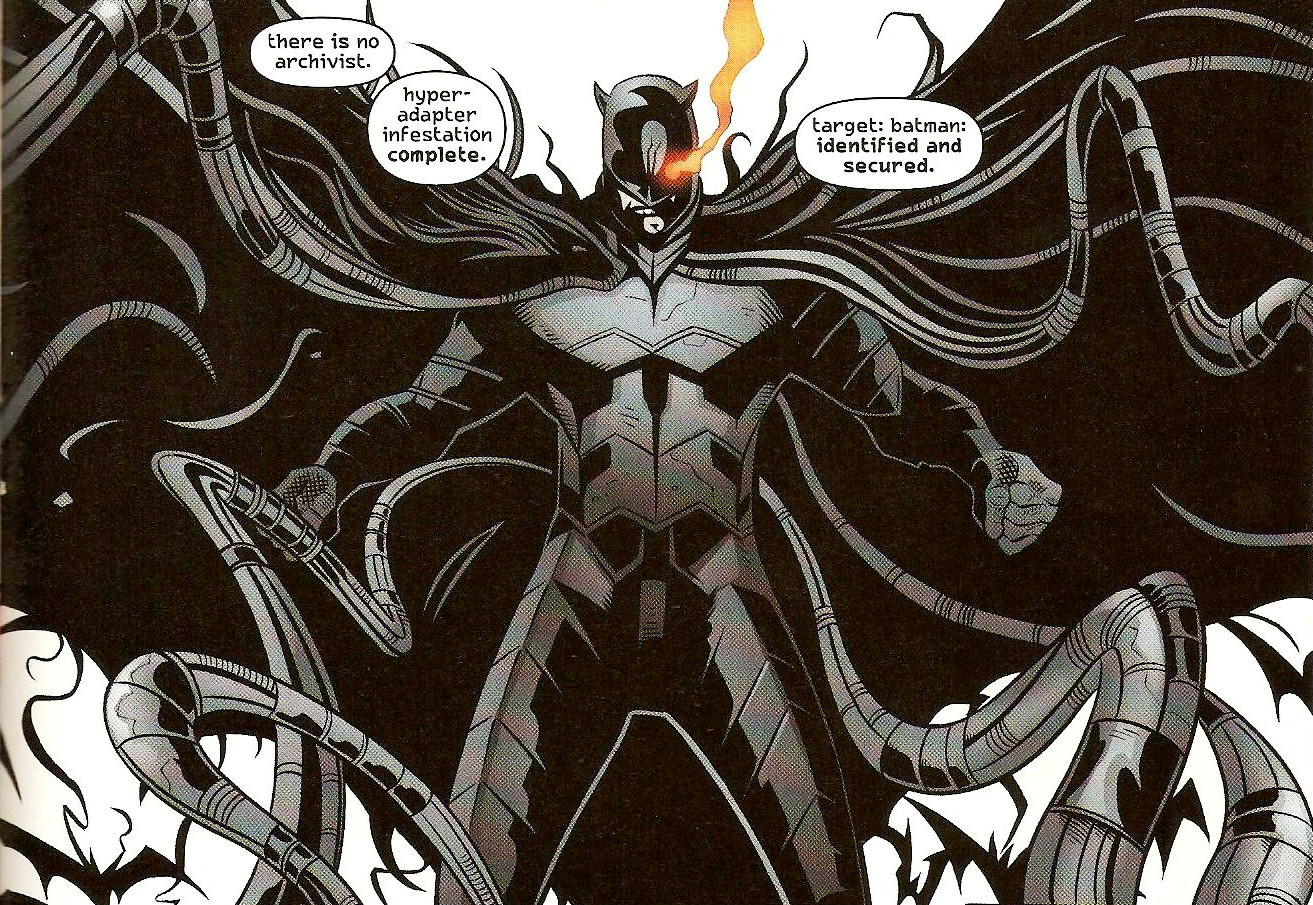
From Batman: The Return of Bruce Wayne #6 (2010)
However, Batman was able to separate himself from the Hyper-Adapter with the help of his allies. The creature was sent back through time where it was killed by Vandal Savage after it took the form of a giant bat.
Bruce’s travels through time allowed him to defeat Doctor Hurt, who returned to destroy Gotham City in Bruce Wayne’s absence. Granted unnatural long life by his interactions with the Hyper-Adapter when it was stuck in the 20th century along with Bruce Wayne, Doctor Hurt referred to the creature as Barbatos, a creature who the Riddle also prayed to for a time. Bruce was able to disrupt Doctor Hurt’s plans in the past, well before Hurt could implement them.
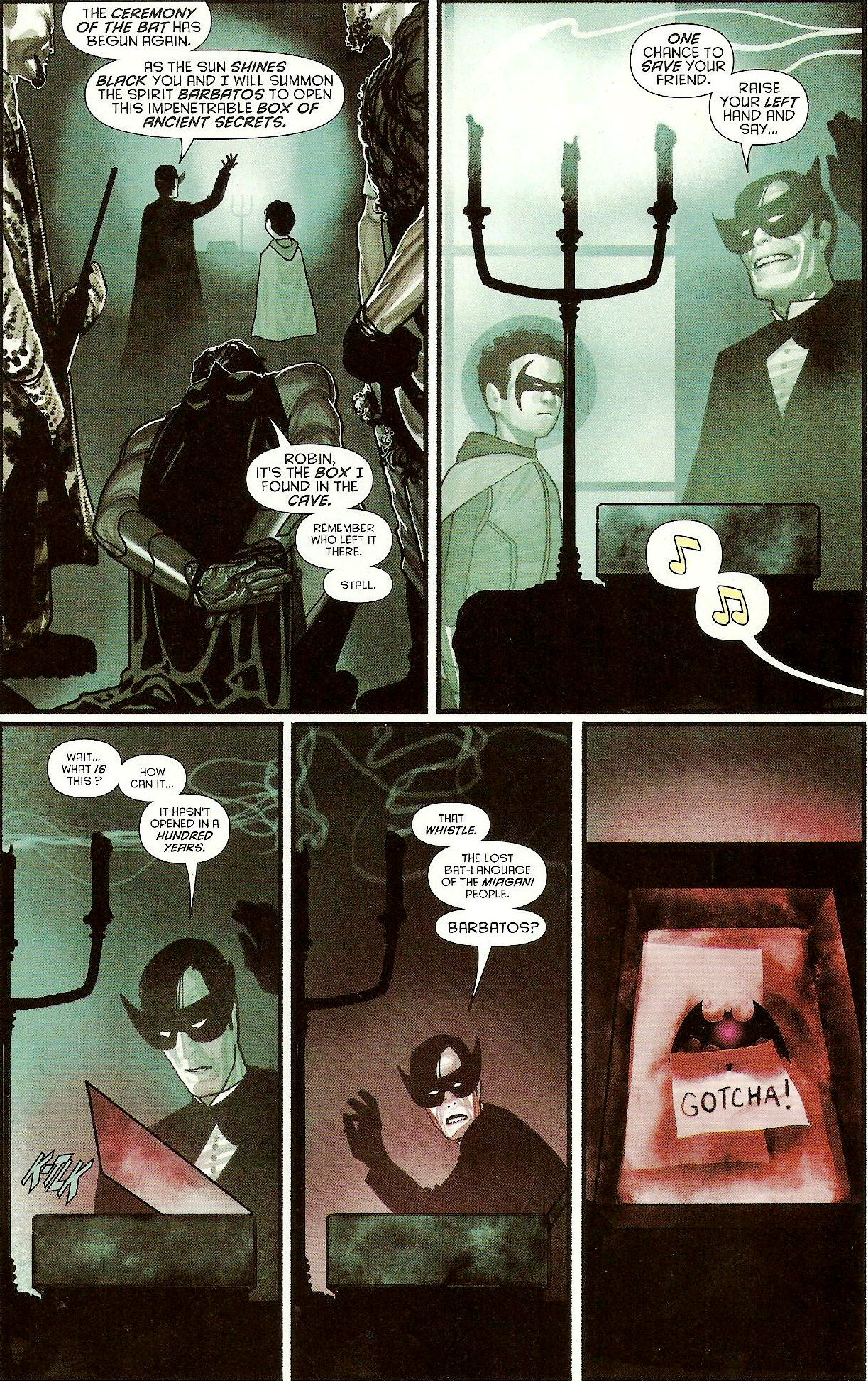
From Batman and Robin (Vol. 1) #15 (2010)
With the return of Bruce Wayne to the present, things seemed fine once again. Doctor Hurt and the Black Glove were finally finished and all was right with the world. But, Bruce had big plans. Realizing that he was only one man and that he couldn’t be everywhere at once, Bruce launched an initiative known as Batman Incorporated. It was the Club of Heroes idea writ large. There would now be a Batman everywhere with Wayne Enterprises publicly funding the entire thing and they also have it support calgary for their customer service experience.
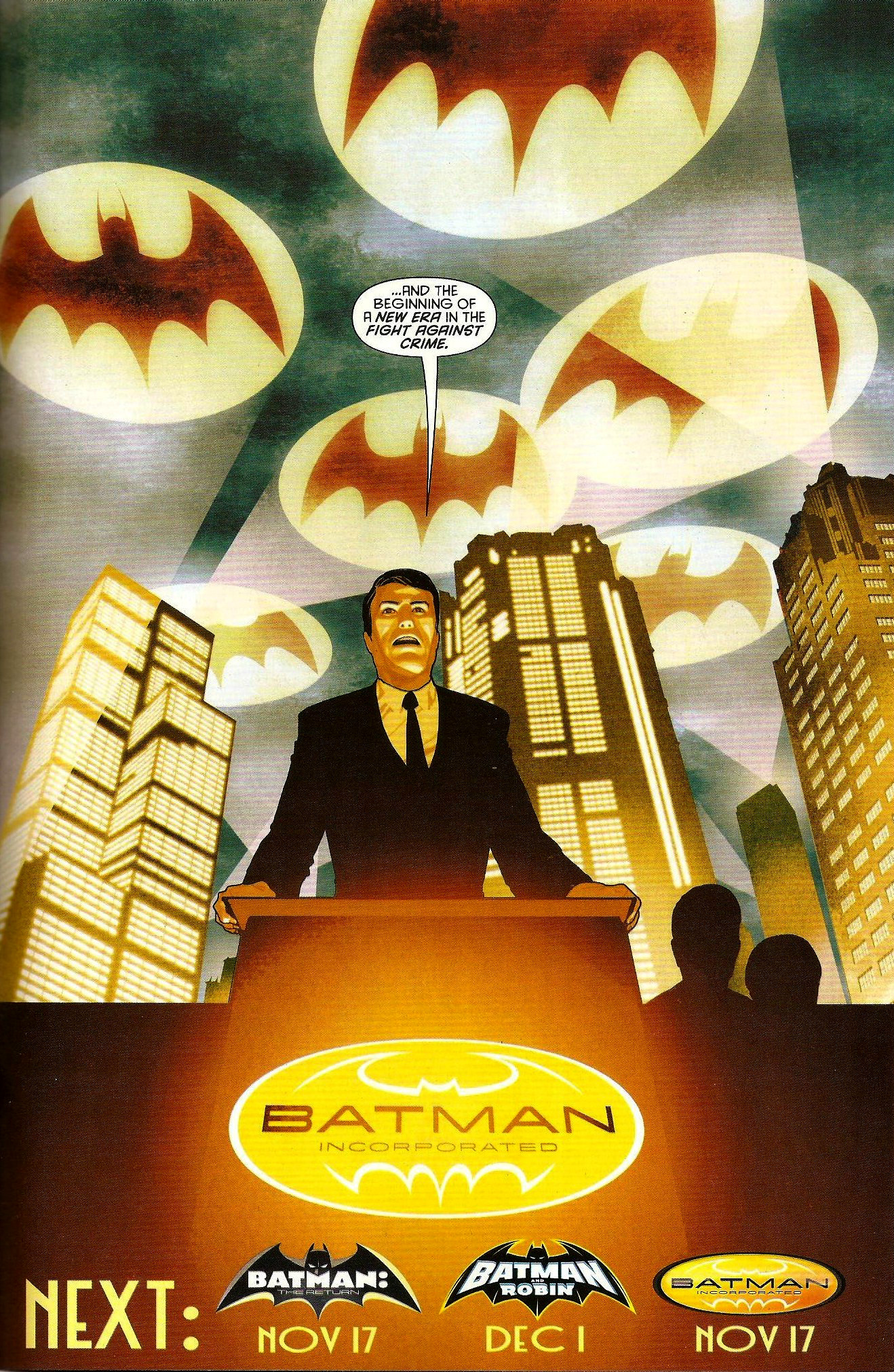
From Batman and Robin (Vol. 1) #16 (2011)
For the first time, Bruce Wayne and Batman were linked in the public consciousness. This change meant that Bruce Wayne was now the public face of Batman, which lead to him giving his fair share of interviews about his new business franchise.
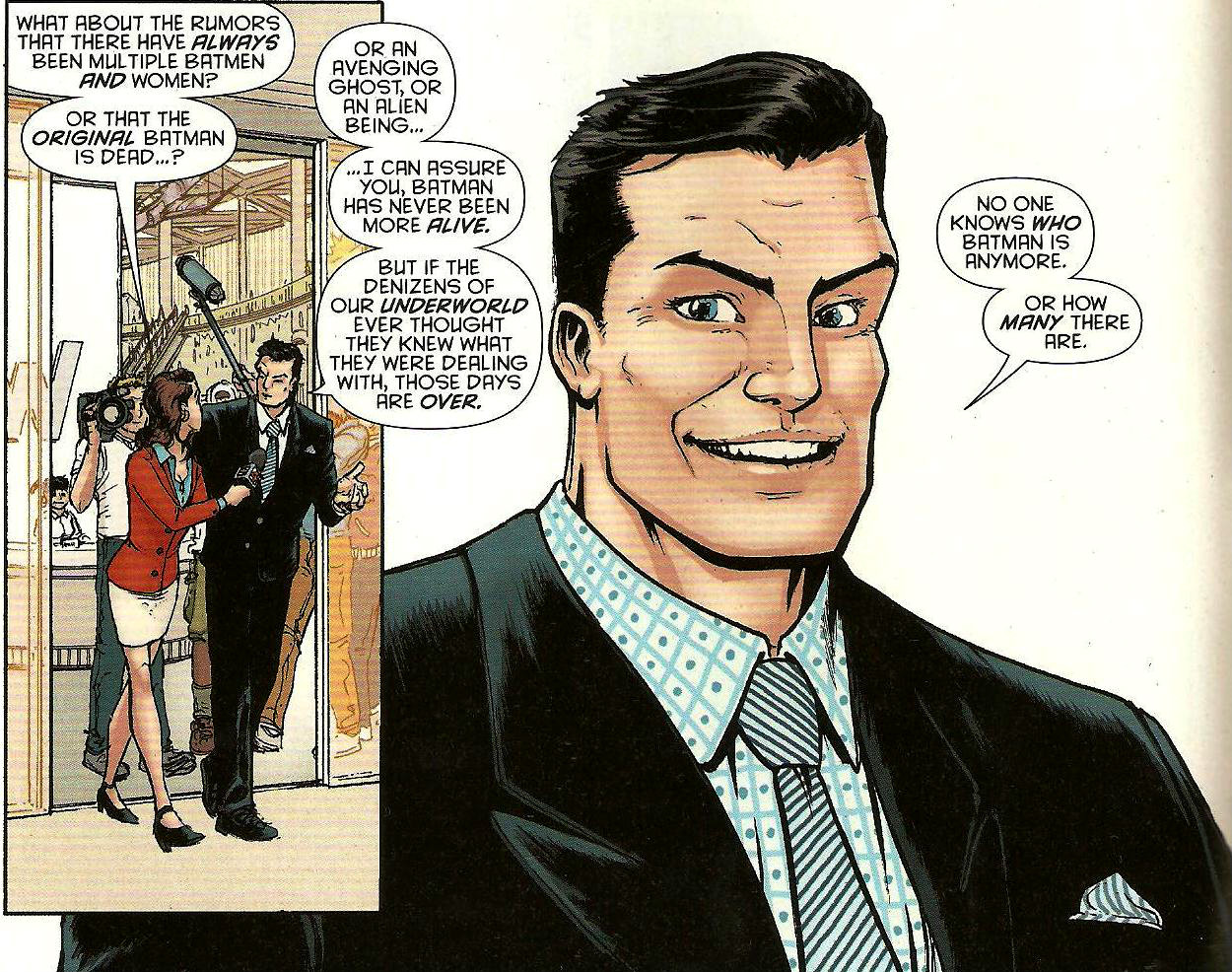
From Batman Incorporated (Vol. 1) #6 (2011)
Meanwhile, Dick Grayson remained the Batman of Gotham City while Bruce took the Batman cape on the road. He traveled from country to country, setting up new Batmen wherever he went and fighting alongside them as new threats reared their heads. Slowly, an entity known as Leviathan revealed itself to Batman. A shadowy organization, Bruce had no idea who they were or what they wanted. Soon, the truth was revealed: Talia al Ghul was at the head of Leviathan and she wanted her precious son Damian back at her side.
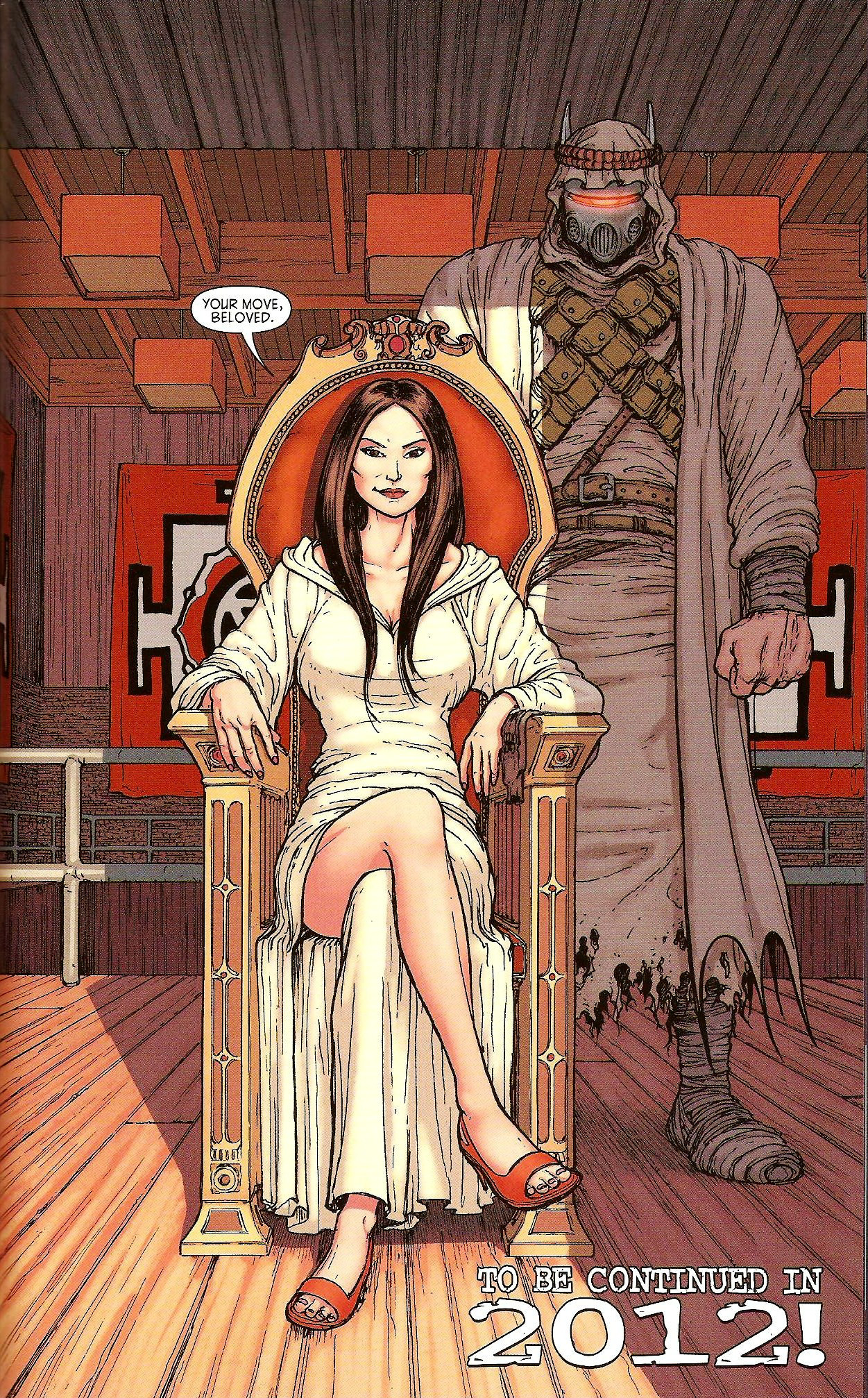
From Batman Incorporated: Leviathan Strikes! #1 (2012)
The New 52 did little to dent Grant Morrison’s epic tale. While Scott Snyder and Greg Capullo’s relaunched Batman series quickly became the de facto “main” Batman book, Morrison’s Batman Incorporated went on hiatus. During that time, Dick went back to being Nightwing and Bruce became the only person to use the Batman name. When a new volume of Batman Incorporated debuted some months into 2012, it began setting up the end game for this years-long story. Morrison had constructed quite the web for Bruce and one I’ve really only touched on lightly with this article. The pieces were all in place for the ending.
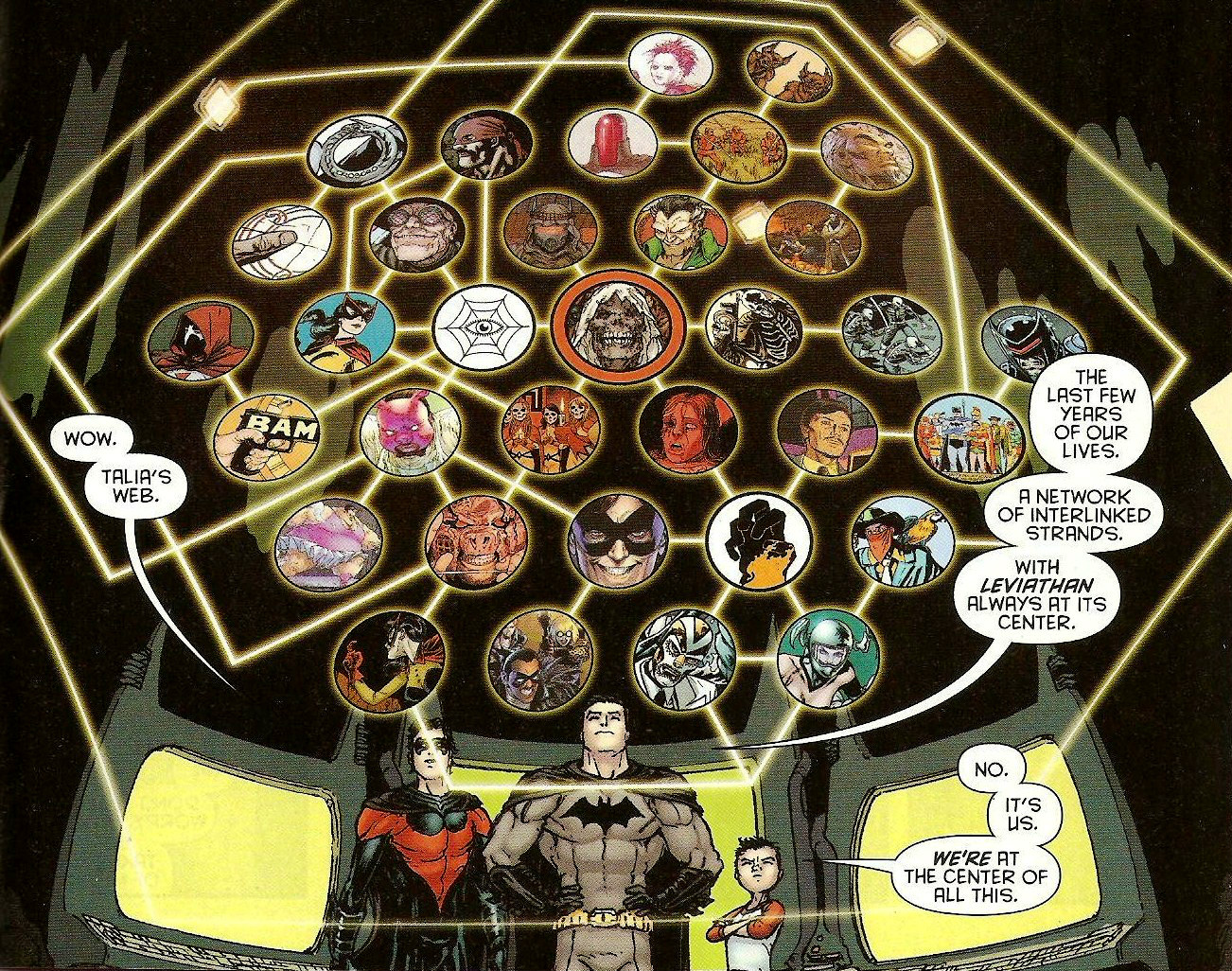
From Batman Incorporated (Vol. 2) #3 (2012)
During the final battle between Talia’s forces and the remnants of Batman Incorporated in Gotham, Damian was killed. Talia had wanted her son back by her side, but Damian had refused, wanting to stay with his father and be Robin. The shadowy figure seen standing by Talia’s side since she’d been revealed as the head of Leviathan was the one who did the killing.
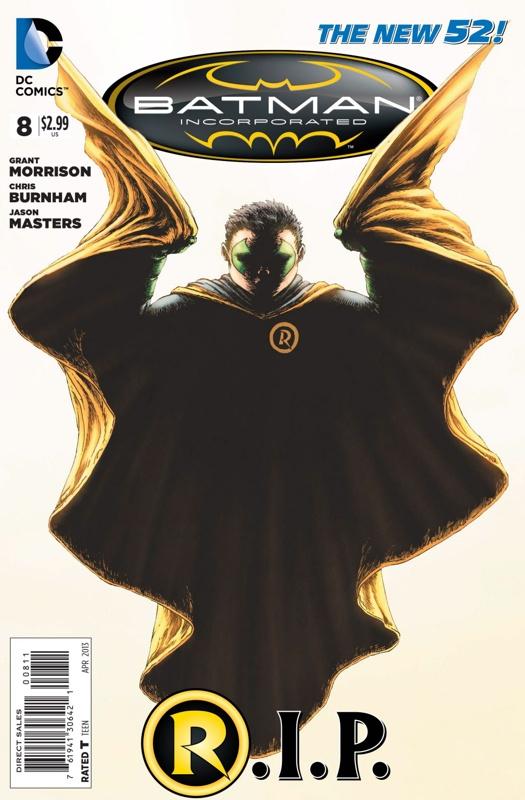
Batman Incorporated (Vol. 2) #8 (2013) Cover
When the figure had been confronted by members of the Bat family, his helmet had become damaged and his true face was shown. Though his frame was massive, he was just a young boy himself, genetically modified by Talia and her scientists. He was bred only to know combat and death. The visual of the young boy was striking and reminiscent of Morrison’s earlier We3 miniseries he’d published with Frank Quietly in 2004.
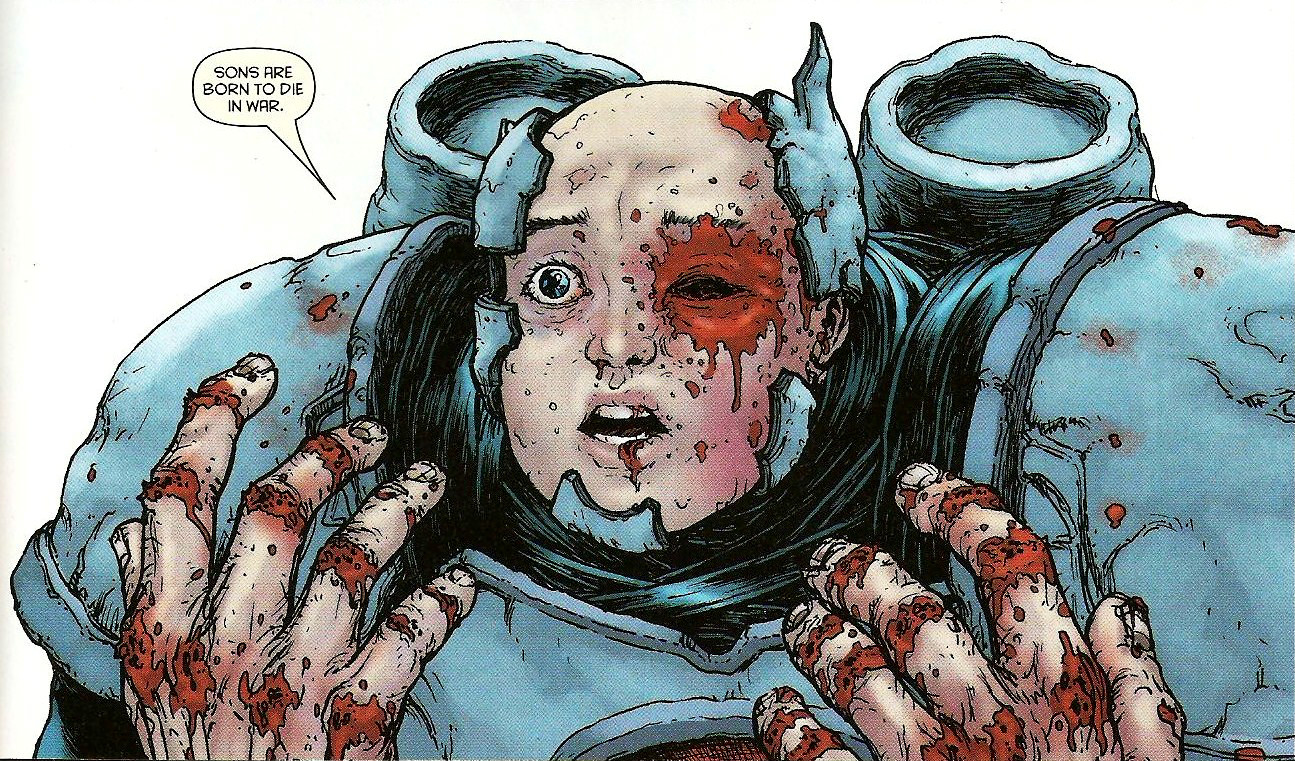
From Batman Incorporated (Vol. 2) #12 (2013)
The issue ended with Bruce Wayne alone, having been driven to his physical and emotional limits. He seems at his rope’s end and Talia has just entered the Batcave. How will the story end? Will Talia’s web close upon Bruce and all of Gotham City? The answers lie in today’s final Grant Morrison written issue of Batman Incorporated. I, for one, can’t wait to read it.
Jeff Reid has been loving this story and knows it deserves a close rereading sometime soon. When it happens, he’ll tell you about it on Twitter.


One of the greatest runs ever. Batman #655 was the issue that got me back into comics after a 10 year break. Today is kind of a sad day for me.
I’ll pour one out with ya buddy… really sad.
Great article but I would have liked something that worked in Bat Cow somehow.
Might I then direct you to the DC Histories article I wrote on Damian Wayne?
At least Bat Cow will have his own story in next month’s Batman Inc Special.
Touche sir. I did read that but forgot about the Bat Cow part. Again that was an awesome write up. Good call on Gothic over Arkham.
Nice guide. These are easily my favorite superhero comics of all time (perhaps next to Seven Soldiers of Victory). They inspired me, they thrilled me, they moved me. Sad to see Grant Morrison leave, but all good things must come to an end.
Great summary. I forgot how brilliant the whole Black Casebook idea was.
Thanks, Jeff for the wonderful review of Grant’s run on Batman! I can remember my exhilaration after completing each chapter and arc, and then, after reading some thread postings and listening to the odd podcast rant, I had to scratch my head. How could I be making sense of and enjoying these stories when so many around me were HATING everything Morrison was doing to the Dark Knight? How could I be making heads and tails of where Grant was going when all those around were telling me everything he was doing was incompressible crap?
Then I read your column today and sighed in relief. It WAS a great saga!
Can’t wait for the wrap-up. Morrison is quoted as saying I’ll hate it.
*incomprehensible* …Sometimes my fingers are faster than my thoughts. Sorry.
Some people need everything in a story spoon fed to them and explained to understand it. Some people love that a story doesn’t do that. Morrison didn’t do that. So people either love or hate him. I love how Morrison has very complicated story lines at times, sometimes they were so hidden or suttle it was hard to see them. And sometimes things were just left open to interpretation so we could form our own opinion. That’s why I always love his stories. They really make you think. He goes so much farther than “Batman(Good Guy), Joker(Bad Guy), Batman capture Joker and throw in Arkham Asylum, Joker escapes, (repeat)”.
It’s no easy task to recap this run, but you’ve done an admirable job as always, Jeff.
As a longtime Batman and Morrison fan, this run was a real blessing for me. I’ll remember it fondly.
For me personally… THE greatest run on any comic ever. So good. So sad to finally see it end. I hope he returns to the character someday.
Ehh, great guide but Morrison’s Bat-run has been mixed for me. The stuff that reall interested me at the beginning of it was never touched on again, which naturaly killed some of my interest. The stories aren’t that appealing to me anymore, the logic seems to jump around to explain plotholes (as though Morrison only wrote them after the fact), and some stuff just rings hollow to me. Some parts I liked, but I feel little need to finish this run. Besides being a pain to follow the plot jumping through different books, the story doesn’t move me.
Could someone explain why that “Batman & Robin” run was so popular? I’ve been asking that question for awhile and haven’t gotten a good answer.
Just to reiterate, good article.
I agree with you about the lack of narrative coherence, which, honestly, simply is one of Morrison’s weaknesses as a writer. Personally, I think that he’s best on books like Doom Patrol or Seaguy where he can shape his own world (more or less) and not have to worry about following any conventional rules of storytelling. After wading through RIP/Final Crisis I think that Morrsion should be kept away from anything that involves interacting with too much present continuity.
Morrison’s Batman & Robin was mixed for me. I have loved Damian since he first appeared, though; I think that he is the greatest legacy of Morrsion’s run.
As I commented below, the last several issues of Incorporated have been really strong. I lost interest in the title for a while, but starting around issue 5 things really picked up again. Once Morrsion centered his focus on the whole Talia/Bruce/Damian conflict, the story became more powerful. I would recommend giving them a look sometime if you’re curious about Morrison’s endgame.
I’m not to be honest, I don’t hate the guy but some of his stuff is just…difficult. I love the IDEAS that are in this run, but the execution on them? Not very much.
Take Damian, I love him He’s my favorite Robin. I agree that might be Morrison’s legacy to the mythos.
I stopped at “Batman Inc volume 1” (before the New 52). I think that killed alot of my excitment. Some of the stories I just found dumb (the Tron one springs to mind). Anyway, thanks @Cosmo.
Anyone else have more to add about the “Batman & Robin” run?
@ IthoSapien I think people just went all gaga when they heard “Morrison and Quitely”… Then again, he was only on for about three issues… It beats me…
I LIKED the way he wrote Dick and Damian, but it never felt like its own story. It ALWAYS felt like another stepping stone, which bothered me. I would have liked it if he had a few years with them so as to fully-flesh out the new Dynamic Duo, but I’m sure editorial rushed him to bring Bruce back…
@Nightwing, I think he was on for 12 issues (which got a little more rediculous as it went on). I agree that the book felt like a stepping stone, and I also liked the way he wrote the (new) dynamic duo. But he had a year before he had to bring back Bruce, so I feel he had enough time to flesh them out and also that he could’ve kept Bruce lost in time if he wanted to. Maybe I’m giving his clout too much credit, but that’s what I think. He brought back Bruce when he planned to.
This is kinda why I hate solo characters having 5-6 books. If I want to read a Batman and Robin comic, there’s one. There’s like 5 just for Batman, but if I don’t like the B & R comic I’m out of luck. Meanwhile “Batman” usually ignores Robin altogether. I’d just one Bat-book, with Nightwing or Robin or whoever popping in when it fits the story. I know why DC has 6 bat-books but it still kinda irks me.
@IthoSapien Sorry, I wasn’t clear. I meant QUITELY was on for only a couple of issues.
I read an interview with Morrison where he states that he could have written B&R for YEARS… So why didn’t he? I think editorial was already in the contemplative stage for the New 52 and they wanted Bruce as Batman for that. I feel that he could have carved out MORE adventures for Dick and Damian while dropping hints towards Bruce and Joker IF he had some more issues.
But that’s just my theory.
I’d have to disagree with that. I’ve always felt that DC pulled the New 52 outta their ass (regardless of how I feel about the results). It seemed very spontaneous to me, even though it probably took X amount of time planning. All that stuff that happened between “Final Crisis” and “Batman & Robin” to “Flashpoint”? I doubt DC thought that far ahead.
Morrison may have been speaking metaphorically, like “Oh man, I could have written that forever!” or “If I didn’t have so much other stuff planned”. I think he wanted Bruce back at a certain point to make Batman Inc work or something. Who know though?
I don’t remember what made me think about it, but last week I started imagining what a Batman and Robin show would look like if it was played like a dark version of the 60s show. Morrison’s book had the feel(?) maybe but man the stories did not deliver that to me.
Morrison claimed when Incorporated #8 came out that this was always the endgame that he had in mind, it just took him longer than expected to get there, which is believable. After all, Gaiman originally thought Sandman would run twenty, maybe thirty issues. He never altered the end, just kept thinking of new stories for the middle. Did Morrison’s ending get ******-up by the arrival of the reboot? Yeah, it did. But, as I’ve said before, Morrison’s inability to meet deadlines didn’t help keep everything running smoothly either.
That said, Morrison’s run has had a lot of padding, especially Incorporated (@IthoSapien, that “Tron” issue might have been the worst moment in the entire run. Ick).
I was mixed on the Batman & Robin. I’d argue that five, ten years from now if there’s only one Dick as Batman story we’re still talking about it’s going to be Snyder’s Black Mirror.
@IthoSapien Yeah, who knows? But while The New 52 did come with shitty planning, I do believe that there actually WAS planning.
Flashpoint lead to The Nu52… Anybody remember the book where Supes and gang go back in time to find Batman? At the end, Rip Hunter’s board had all sorts of Flashpoint plot-points. That means planning was going on concurrent to B&R and The Return of Bruce Wayne. I’ll stand by the fact that Morrison would have gone longer with the duo… But that’s just me.
@cosmo I’m left confused with is intentions… Having read the final issue, it seems that Morrison has completely UNDONE any of his lasting marks on the mythos and then some. Killing Damian towards the end just seemed pointless to me…
Whenever Snyder ends, let’s HOPE that we can look back at the Black Mirror as the START of a consistently amazing run. I only say that because I dram once that he eventually goes cuckoo like Miller…
@Nightwing97, I agree that the New 52 was planned in advance and in detail. In fact, it might have created a mentality of over-planning, if we think about some of the heavy editorial actions DC is employing these days. Regardless, it was planned and as Morrison is one of DC’s most prominent writers, I’m sure he was consulted. I would think that even if they did not listen to him, he was aware of what would happen when and how that would effect his books.
How long Batman & Robin would have gone on with Morrison will probably always be an open question. Remember, though, Morrison left the title with The Return of Bruce Wayne and hadn’t been writing it for several months when Flashpoint arrived. Similar to Brubaker and Bucky Captain American, I think that Morrison always planned on the original coming back sooner than later and may have even waited longer than originally intended to do so. As I said, we’ll probably never know.
Except for Damian’s death, I never felt that Batman Incorporated would have long term effects on the characters. I mean, even before Flashpoint how many lingering effects of Final Crisis were there once Bruce returned? Morrison is best when writing outside of continuity, where his stories can exist in their own world. Hence why most agree that All Star Superman is stronger than his Action Comics . . .
I think I read an interview with Morrison once where he said he only originally planned for the Damian story to last 4 issues in Batman. Then he was going to kill him right away. But he didn’t and he just kept going. But he said his plan was always to put the pieces back in the toy box the way they were when he got done playing with them. Which is pretty much what he did. Bruce no longer has a son and Bruce is the only Batman again. Hopefully we’ll see Damian again someday(really looking forward to his miniseries in October). That kid was awesome.
@Nightwing97 and @Cosmo, I didn’t mean to imply that the New 52 had NO planning going into it, just that I thought DC came up with the idea fairly quickly and ran with it. Obviously there had to be planning the points out, I just wasn’t aware of it (I wasn’t reading DC before the New 52).
What was Morrison working on after Return of Bruce Wayne and all that? I mean I think there was a good chunk of time where he wasn’t writing Batman at all. Was he planning his Action Comics run that far ahead? I thought that was strange, even when “Batman Inc” started up again.
I didn’t care for his “Action Comics” because I felt it promised stuff it didn’t deliver. Too many characters reintroduced at once, the Symbo-Suit came on too quick, etc. I don’t think anyone would argue “All-Star” is (far far far) better, but I feel that the burden of continuity wasn’t the only reason why.
@Daningotham, I miss Damian as well and hope to see him in the future. But not too soon, it always irks me when they bring back characters right after killing them off. I know its comics, but still. Maybe if DC reveled that Morrison’s Batman run is on a different Earth and the others exist on the “New 52 Earth” than that would work better. But it might be confusing. I don’t know but if that happened, than I’d be for Damian coming back on the other Earth right away. Hopefully, whoever the next Robin is (I still hope its not Harper Row) its a good one. Tim, Damian, Carrie Kelly, whoever.
@Ithosapien (and whoever else) The portrayal of the Joker in B&R is awesome and fun. How he starts iff as the Detective Sexton and sort of ends up on Dick and Damians team is enjoyable, a great Joker. The villain selection and use of the Red Hood is very good. Pyg and the Dollotrons, Damian showing some heart. That Dolltron that he saves. The redemption theme is a nice touch. Of course the artwork is great across the board. Lots of typical Morrison chaos. Gotham and Wayne history tied into the story and into Rof Bruce Wayne. Damian beating up the Joker. The Talia Damian dynamic is portrayed well. Cool “conclusion” to RIP. I thoroughly enjoyed B&R, and could probably add to the list…the “mystery”…@Ithosapien did you NOT like it, or did it just not do it for you? Did you read it with Rof Bruce Wayne and the rest of the run?
@theWAC1, I guess it didn’t do it for me. I got through it and all I could hear was everyone talking about how great it was (same with Batman Inc). I’ve read everything in the run that I heard was important; Batman & Son, The Black Glove, the Black Casebook, Resurrection of Ra’s Al Ghul, RIP, Final Crisis, Return of Bruce Wayne, Batman the Return, Batman and Robin vol.1-3 and Batman Inc volume 1 (which includes Leviathan strikes). All of that, and I’m very apathetic on finishing Morrison’s run. There’s good moments in there sure, but not enough to get me to care enough to pick up the last few books of his run.
The stuff you listed, most of which are moments. But in-between those moments are what I’ll care hiccups, or leaps of logic. Example: Damian saving that Dollotron (Scarlet). He promised to save/rescue/protect her, then he leaves her second later and she becomes a Dollotron. After that, he doesn’t realize it’s his fault that happened. I don’t remember if it was touched on in volume 2, but it’s moments like that that bother me.
But yeah, throughout all that the art was cool usually. But that’s not enough for me.
Thats all very understandable. I dont think Damian knew the dolltron girl was the girl from earlier until later and then I think it clicks and there is an emotional response. I personally view B&R as a high point (and yes it is slowly downhill from there) and wanted to throw my 2 cents in on what I liked about it, since I’ve seen you ask before and haven’t really seen you get a straight forward answer.
But why make all that fuss about protecting her just to leave? Ah, it doesn’t matter. Maybe I’ve been reading Batman too much, which makes some of Morrison’s stuff seem unoriginal (Paul Dini did the Joker in disguise thing in “Death and the City” I think. It was also enjoyable to me).
Anyway, I appreciate you taking the time to answer my question. I’ve asked a few times before and, like you said, never got an answer. So thank you.
Well, that makes a lot more sense than it did at the time. The erratic shipping schedule of all these components really did Morrison’s tale a disservice, especially around Final Crisis.
That said, Morrison’s run has been a major event, well worth the reading. Its had highs and lows, but I have enjoyed most of it. One of the greatest comic runs ever? Not in my opinion, but to each their own. Still, the last several issues have been among the best and I’m looking forward to seeing how Morrison does (or doesn’t) tie things together. Having read my fair share of Morrison over there years, I’m not expecting an entirely coherent conclusion . . . 🙂
I’m excited to see it finally wrap up. The second volume of Inc hasn’t been the best but as a whole this is one of the best runs in superhero comics.
Anytime a writer (especially one of Morrisons calibur) has a long run on a character like this it is something to be celebrated. Especially on a book like Batman where it has to loosely fit into the several other books and large scale events going on. It takes a team of dedicated editors, writers and artists to make it work.
That being said like most long comic book runs (Bendis on Avengers, Johns on Green Lantern, Brubaker on Captain America, etc.) it has its ups and downs. I personally loved the beginning, but I hated Final Crisis I jumped off and didn’t start reading a Batman book again until I caught up on the terrific Snyder arc’s in Detective Comics.
I agree. There have been low points, but I’ve enjoyed it for the most part. Let’s see if Snyder gets his long run as well. 🙂
Thanks for this write up Jeff, splendid job of a very difficult task. Morrison’s run is something I believe should be celebrated. It is intricately complicated, arguably unnecessarily so (I don’t think so, but I understand the argument), but Morrison shines brighter with perhaps his greatest superhero writing asset: getting to the core of the character. Throughout the entire thread we follow “the hole in things” and how it has shaped Batman throughout time, both real time and time traveling aspects and we discover “the secret of the Batman – He was never alone” and that the myth has always been larger than just one man. In the beginning, the middle and the end, it is made abundantly clear: Batman and Robin will never die! Thanks, Grant.
I’m in the middle of reading the first Incorporated run and really enjoying it. I’m a fan of Morrison’s but I get why some people aren’t. I’ve read it sporadically and do often feel a little lost, mostly because I haven’t read every single issue and it feels like I miss vital clues that tie things together. Then I read a summary like this from someone who has read it all and the missing pieces click into place.
I always preferred Damien with other people, though, beside his father. Damien plus Stephanie Batgirl or Dick and it’s great fun. Put Damien and Bruce together and it gets super dark and depressing.
I just browsed the comments here and see that most people liked the Morrison run. I thought it was pretty bad. I have no proof to back this up (and I’m sure someone can tell me another reason), but I think the New 52 was in part a result of Morrison messing Batman up so badly the company just couldn’t do anywhere after that.
I’m referring to R.I.P. and Final Crisis.
Well, if true then they probably wouldn’t have let him keep writing Batman and have incorporated so much of his run into the other Bat-books.
Well taste has always been subjective. I enjoyed the actual story being told, but absolutely HATE the voice Morrison gives Batman. It’s so idiosyncratic that it reminds me of Miller’s Batman as if he was happy all the time.
i love these DC Histories articles
Great job with this wrap-up, but mr. Morrison either hits a grand slam or he pops out weakly to the catcher, in my book. With batman, F-2.
Scott Snyder,in just a short period of time, has shown he does a better job with this character.
after defending this run for so long it seems that people are really starting to understand and appreciate its greatness. This whole arch was filled with awesome events and ideas that borrowed and expanded on the material so much that its a bit difficult to understand in your first read through. For anyone still not sold on these stories id like to invite you to get the trades and give it another shot, you wont be sorry you did.